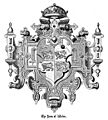Llywelyn's coronet facts for kids

Llywelyn's coronet, also called Talaith Llywelyn in Welsh, is a very important lost treasure from Welsh history. It was a special crown belonging to Llywelyn ap Gruffudd, who was the Prince of Wales and Lord of Aberffraw. In 1282, before his last battle, Llywelyn left this crown and other valuable items, like the Cross of Neith, with monks at Cymer Abbey to keep them safe.
Sadly, Llywelyn was killed later that year. In 1284, after the Kingdom of Gwynedd was defeated, King Edward I of England took the crown and other holy items. He took them to London and placed them at the shrine of Edward the Confessor in Westminster Abbey. This was a way to show that Wales was no longer an independent country.
Llywelyn's brother, Dafydd ap Gruffudd, became the next Prince of Wales. But his rule was very short. He was also killed soon after his brother. He never had the chance to get the precious items back from Cymer Abbey.
Contents
When Was the Crown Made?
The exact age of Llywelyn's coronet is not clear. Some people think that Dafydd ap Llywelyn received a coronet from Henry III of England in 1240. This was when Dafydd became the ruler of Gwynedd. However, when Dafydd first met Henry, he was already wearing a coronet.
Historian Rees Davies believes there might have been several coronets. One of the crowns taken in 1282 was possibly the "Coron Arthur." This was an older Welsh treasure. It might have been made as far back as the time of Owain Gwynedd (1137–1171). The princes of Gwynedd wanted to show they were the main rulers of Wales.
R.R. Davies wrote that King Edward I took the most important Welsh symbols. These included Llywelyn's coronet, his royal seal, and the jewels and crown of Arthur. He also took the most cherished Welsh relic, the Cross of Neith. Edward I did similar things in Scotland, like taking the Stone of Scone in 1296.
It is not fully clear if Llywelyn's coronet was the same as the "crown" or "jewel" of Arthur. Some old writings mention them, but it is confusing if they were one item or two separate, valuable treasures.
What Happened After England Took It?
According to King Edward I of England's records from 1283, the crown was covered in gold. This was done to make it look more impressive. This suggests the crown might have been made of iron originally. It was then placed at the shrine of Edward the Confessor in Westminster Abbey. It was called the "Coron Arthur," or the Crown of King Arthur.
The coronet stayed in Westminster Abbey with the English Crown Jewels until 1303. Then, all the crown jewels were temporarily stolen. After they were found, they were moved to the Tower of London. Many people think Llywelyn's Coronet was destroyed in 1649. This happened when Oliver Cromwell ordered most of the original English crown jewels to be broken up. However, a list made before the destruction does not mention this specific coronet.
Owain Glyndŵr's Crown and Later Versions
There is also a mystery about a possible second Welsh crown. This is the crown of Owain Glyndŵr. Glyndŵr was crowned in 1404 at the Welsh parliament, called the Cynulliad, in Machynlleth. But no one knows which crown he used.
It is possible that this was another old Welsh crown, like Llywelyn's. It might have been the crown of the Kings of Kingdom of Powys, known as the Crown of Elisig. Or, it could have been a new crown made just for his crowning. Another idea is that Llywelyn's crown, which was stolen in 1303, was never returned. If so, it would have escaped being destroyed by Cromwell. If this is true, the crown might have been lost when Harlech Castle fell in 1409. It could even still be hidden in Glyndŵr's secret final resting place.
Modern Prince of Wales Crowns
In more recent times, new Welsh crowns have been made. These are called the Honours of the Principality of Wales. They are used for special ceremonies when the eldest son of the King of England becomes the Prince of Wales.
The design for these coronets was set in 1672 by King Charles II of England. They feature "Crosses and flowers de Liz with one Arch and in the midst a Ball and cross." The coronet made in 1911 for the future King Edward VIII followed this design.
The coronet made in 1969 for the investiture of Charles, Prince of Wales was different. The 1911 crown was with the Duke of Windsor in France at the time. The 1969 version used modern designs and methods. Both of these coronets are now kept at the National Museum Cardiff.
Images for kids
-
This is the badge of the Wales Herald Extraordinary. It shows the Cross of Neith on top of a Welsh Talaith, which is likely Llywelyn's coronet.



